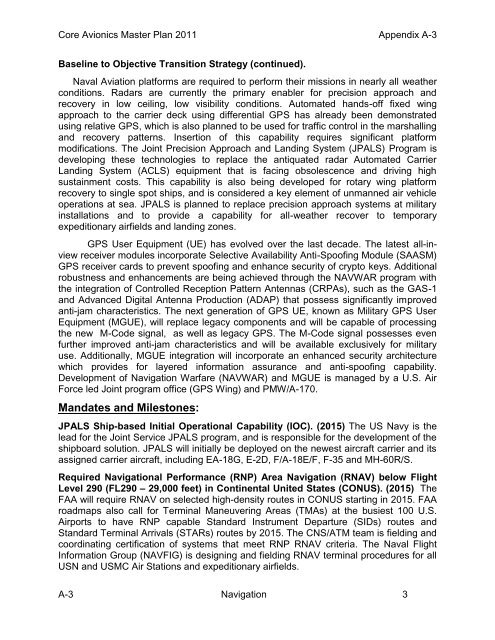Core Avionics Master Plan - NAVAIR - U.S. Navy
Core Avionics Master Plan - NAVAIR - U.S. Navy
Core Avionics Master Plan - NAVAIR - U.S. Navy
- No tags were found...
You also want an ePaper? Increase the reach of your titles
YUMPU automatically turns print PDFs into web optimized ePapers that Google loves.
<strong>Core</strong> <strong>Avionics</strong> <strong>Master</strong> <strong>Plan</strong> 2011 Appendix A-3Baseline to Objective Transition Strategy (continued).Naval Aviation platforms are required to perform their missions in nearly all weatherconditions. Radars are currently the primary enabler for precision approach andrecovery in low ceiling, low visibility conditions. Automated hands-off fixed wingapproach to the carrier deck using differential GPS has already been demonstratedusing relative GPS, which is also planned to be used for traffic control in the marshallingand recovery patterns. Insertion of this capability requires significant platformmodifications. The Joint Precision Approach and Landing System (JPALS) Program isdeveloping these technologies to replace the antiquated radar Automated CarrierLanding System (ACLS) equipment that is facing obsolescence and driving highsustainment costs. This capability is also being developed for rotary wing platformrecovery to single spot ships, and is considered a key element of unmanned air vehicleoperations at sea. JPALS is planned to replace precision approach systems at militaryinstallations and to provide a capability for all-weather recover to temporaryexpeditionary airfields and landing zones.GPS User Equipment (UE) has evolved over the last decade. The latest all-inviewreceiver modules incorporate Selective Availability Anti-Spoofing Module (SAASM)GPS receiver cards to prevent spoofing and enhance security of crypto keys. Additionalrobustness and enhancements are being achieved through the NAVWAR program withthe integration of Controlled Reception Pattern Antennas (CRPAs), such as the GAS-1and Advanced Digital Antenna Production (ADAP) that possess significantly improvedanti-jam characteristics. The next generation of GPS UE, known as Military GPS UserEquipment (MGUE), will replace legacy components and will be capable of processingthe new M-Code signal, as well as legacy GPS. The M-Code signal possesses evenfurther improved anti-jam characteristics and will be available exclusively for militaryuse. Additionally, MGUE integration will incorporate an enhanced security architecturewhich provides for layered information assurance and anti-spoofing capability.Development of Navigation Warfare (NAVWAR) and MGUE is managed by a U.S. AirForce led Joint program office (GPS Wing) and PMW/A-170.Mandates and Milestones:JPALS Ship-based Initial Operational Capability (IOC). (2015) The US <strong>Navy</strong> is thelead for the Joint Service JPALS program, and is responsible for the development of theshipboard solution. JPALS will initially be deployed on the newest aircraft carrier and itsassigned carrier aircraft, including EA-18G, E-2D, F/A-18E/F, F-35 and MH-60R/S.Required Navigational Performance (RNP) Area Navigation (RNAV) below FlightLevel 290 (FL290 – 29,000 feet) in Continental United States (CONUS). (2015) TheFAA will require RNAV on selected high-density routes in CONUS starting in 2015. FAAroadmaps also call for Terminal Maneuvering Areas (TMAs) at the busiest 100 U.S.Airports to have RNP capable Standard Instrument Departure (SIDs) routes andStandard Terminal Arrivals (STARs) routes by 2015. The CNS/ATM team is fielding andcoordinating certification of systems that meet RNP RNAV criteria. The Naval FlightInformation Group (NAVFIG) is designing and fielding RNAV terminal procedures for allUSN and USMC Air Stations and expeditionary airfields.A-3 Navigation 3
















